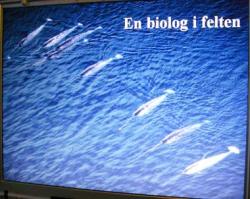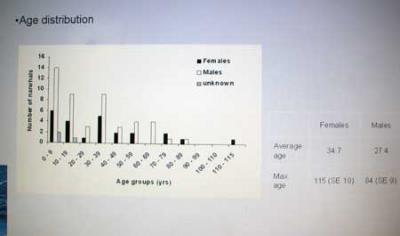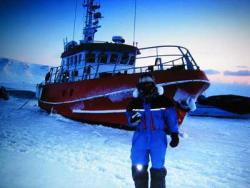Greenland provides many opportunities for research. It has not been studied expensively in the past, but with an interest in marine mammals, climate change, Polar bears, and with new technology making research less difficult, Greenland serves many research interests. In the village of Ittoqqortoormiit this July and August scientists from Denmark, Norway, and the United States have been helping the economy here as they use the village as a base. But research is not easy, and with the climate here allowing only a limited window to conduct research, scientists come and often cross their fingers. Two Norwegians lived here for a few weeks as they studied different types of lichen and moss endemic to this area. One Danish woman has spent a good portion of her summer watching the bay waiting for the hunt. Eva Garde is a Danish biologist studying narwhal.

Narwhal photo courtesy of www.wikipedia.com and K. Bruce Lee Photography
Arriving on July 14, her home has been here at the guesthouse in Ittoqqortoormiit for the last four weeks. Visits with local hunters this summer have been used to establish connections and make a request that the hunters collect biological samples of the narwhal as they cut up the carcass. The tissue, when placed in Eva’s possession, will net 500 kroner for the hunter. Samples collected before she arrives, can be frozen. Eva had hoped for successful narwhal hunting this July, but only three have been shot and harvested recently. This season she has been able to collect samples from 13 individuals.
The number of narwhals that pass through this area, is not known yet, nor is the total number of whales on the East coast of Greenland. For some years, satellite transmitters have been placed on narwhals on the northwest coast of Greenland, giving scientists an idea about migration routes and populations. Scientists do know that the narwhal that migrate along with the west coast is a different population than those that can be seen along the east coast. What is known is primarily about the populations that travel down the western side of this great island. There, every three years a calf is born. An Age Estimation of narwhals using Acid Racemization technique was the title of Eva’s masters degree, obtained at the University of Copenhagen.

This is the cover slide for a presentation of Eva Gardes narwhal research. Photo taken by Mads Peter Heide-Joergensen

The age distribution of the narwhals sampled. The oldest narwhal female was close to 115 years old.
A lot remains to be learned about narwhals. Eva’s PhD project is to examine the reproductive health of this marine mammal, Monodon monoceros. After determining the age of an individual; an analysis of the tissue will determine at what age narwhals reach sexual maturity, at what age a fetus is carried, and how many young a female may deliver in her life span.
A second interest in her research is to gather enough data to trace their evolution back as much as 40,000 years. The current narwhal population appears to have very little diversity, and there is speculation that as the Arctic ice sheet has shifted through time, a bottleneck may have occurred. as But no one has, as of yet, been about to make any correlations between climate changes, and the limitations it may have created for marine mammal species.
Collections will occur for two additional years, with the hope that 100-150 samples from the eastern side and additional samples from the western side will gathered.

*Assisting in walrus research, Eve Garde is prepared for the cold. *


Comments